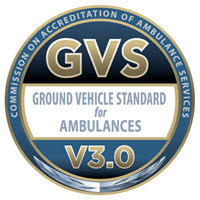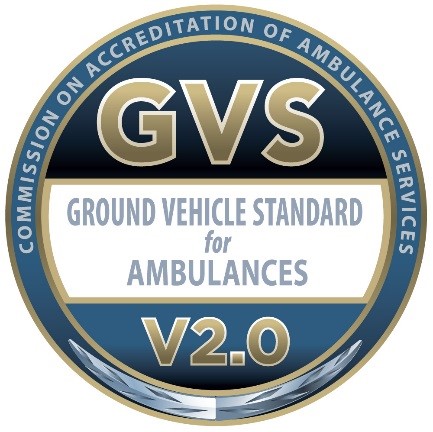
VERIFICATION INFORMATION FOR PURCHASERS AND INSPECTORS OF CAAS GVS VEHICLES
- NEW PRODUCTION VEHICLES CERTIFIED TO GVS V2.0
Your new ambulance has been certified by the Final Stage Ambulance Manufacturer (FSAM) as compliant with CAAS GVS V2.0. The FSAM is obligated to certify to the purchaser that the ambulance bearing the CAAS GVS V2.0 label, its components and equipment meet or exceed all the requirements and tests set forth in the standard. See CAAS GVS Section D for additional information on verification of these requirements. This certification requires three documents to verify compliance:
1) A serialized multicolored CAAS GVS V2.0 Certification Sticker on the vehicle.
2) A multicolored Vehicle Compliance and Exception/Variance Verification document (per Appendix 1, Figure 2) signed by the FSAM and provided to you.
3) A multicolored Payload Calculation and Verification document (per Appendix 1, Figure 3) signed by the FSAM and provided to you.
Samples and detailed information for each of these documents is provided herein. For additional information, contact info@groundvehiclestandard.org.
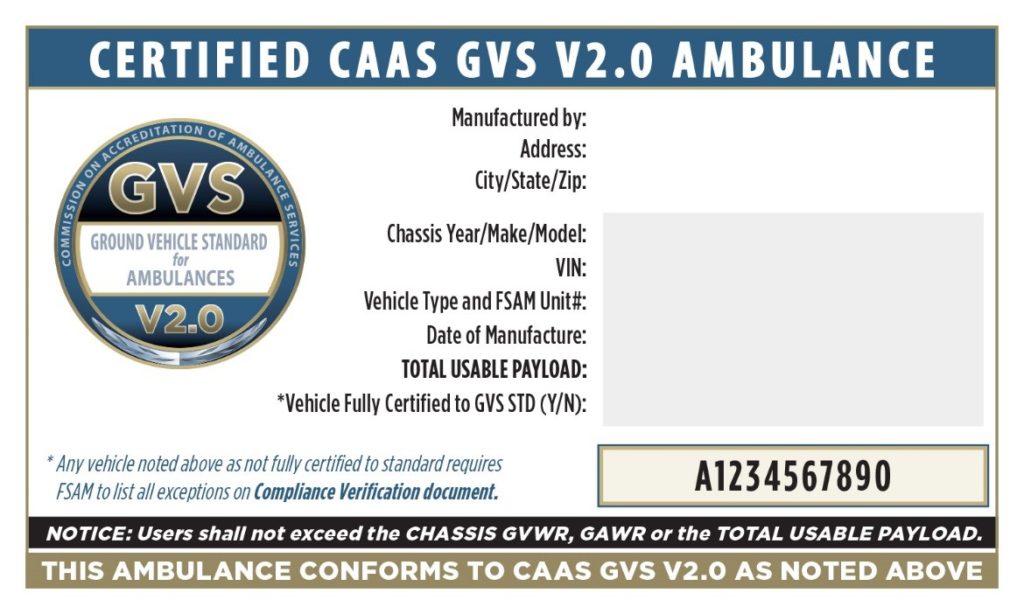
The CAAS GVS V2.0 serialized Certification Sticker provides verification by the FSAM that they have successfully certified an ambulance model, components and equipment comparable to your vehicle. They further verify that they currently hold valid CAAS GVS type certifications for that vehicle from an independent accredited laboratory, as required by CAAS GVS Provision D.3. The FSAM must provide the letter of certification for a comparable model from that laboratory upon your request.
NOTE: CAAS GVS provides these stickers and associated document templates to FSAM companies who attest that they will comply with all verification and certification requirements for vehicles they produce. Buyers should perform their own due diligence to verify that the manufacturer is in compliance per Section D. CAAS GVS provides no recommendation or validation of any ambulance manufacturer or their certifications, and cannot be held responsible for any discrepancy, misunderstanding or misrepresentation by a FSAM.
The sticker provides vital information about your vehicle, including TOTAL USEABLE PAYLOAD, as well as a caution that the vehicle should never be used if the chassis Gross Vehicle Weight Rating (GVWR), Gross Axle Weight Ratings (GAWR) or the Total Useable Payload are exceeded. See section C.6 for additional information.
Your vehicle may not be fully certified if some exception/variance to a minimum requirement in the GVS standard has been mandated by you or the builder. The FSAM provided sticker states that the vehicle IS or IS NOT fully certified to the GVS standard by displaying a “Y” or “N” in the last field of the window. If the vehicle is not fully certified for any reason (an “N” has been entered in the field), the FSAM must list all exceptions/variances to the standard on the Vehicle Compliance and Exception/Variance Verification document provided to you. Be aware that vehicles not fully certified may not be eligible for licensure in your operating area based on local/state regulations and requirements. Contact your State EMS Office if you have any questions regarding compliance with State regulations.
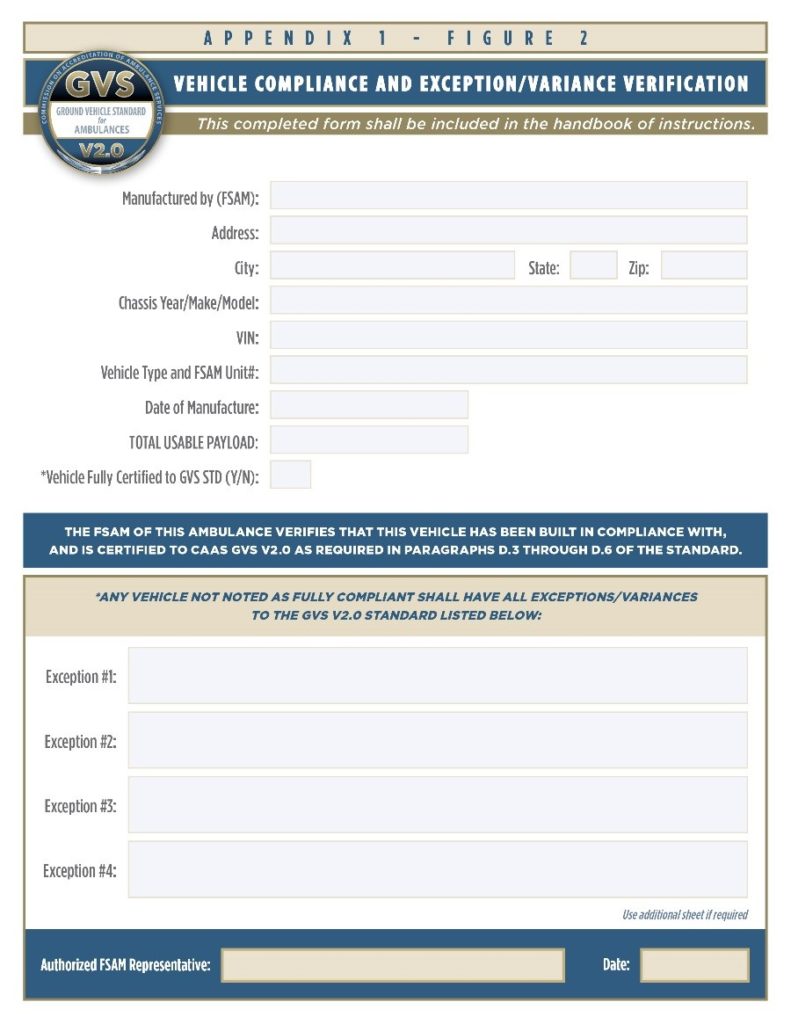
The Vehicle Compliance and Exception/Variance Verification document requires the FSAM to provide further detail on any exceptions to compliance of your specific vehicle to the CAAS GVS standard. Like the Certification Sticker referenced above, this document states that the vehicle IS or IS NOT fully certified to the GVS standard by displaying a “Y” or “N” in the last field of the upper window. If the vehicle is not fully certified for any reason (an “N” has been entered in the field), the FSAM must list all exceptions/variances to the standard on the bottom half of the document.
Be aware that vehicles not fully certified may not be eligible for licensure in your operating area based on local/state regulations and requirements. Contact your State EMS Office if you have any questions about these criteria. The document shall be signed by an authorized employee of the FSAM.
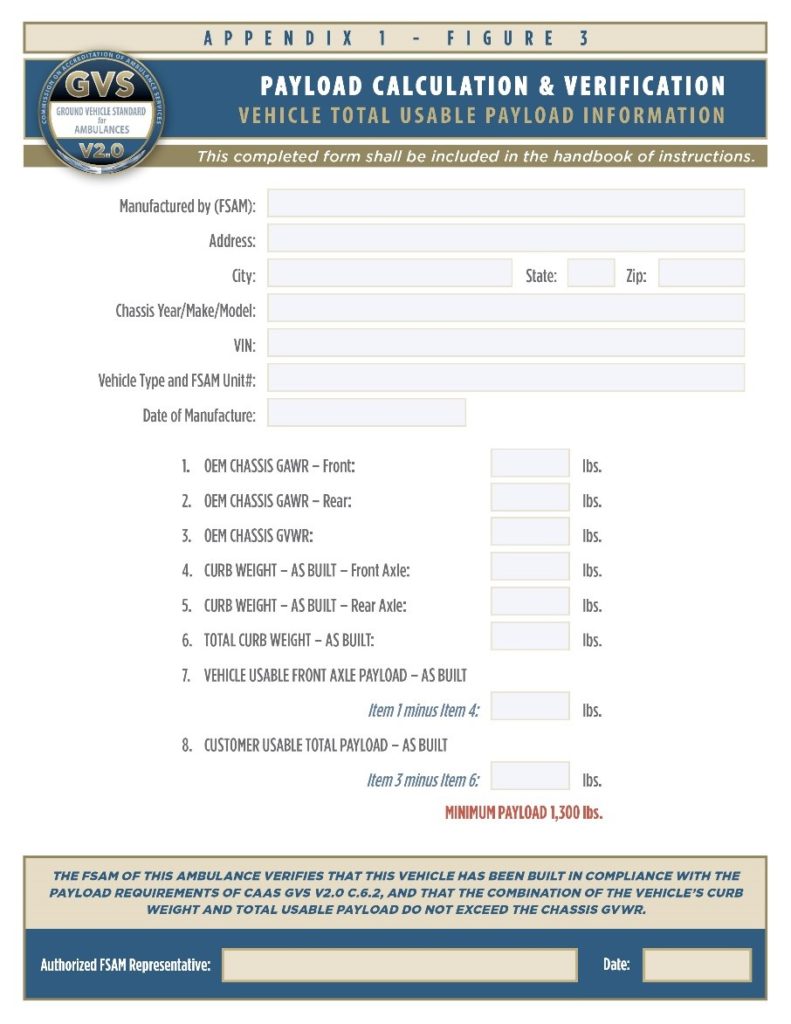
The Payload Calculation and Verification document requires the FSAM to provide further detail on the weight and payload of your specific vehicle in accordance with the CAAS GVS standard. The document provides detailed information and payload calculations for your vehicle. Item 8 provides your TOTAL USEABLE PAYLOAD, which cannot be less than the 1300 pound minimum required by GVS C.6.2.
Users should also be aware of both the Vehicle Useable Front and Rear Axle Payloads when determining equipment and passenger requirements for the vehicle fully outfitted for service. Additional criteria for weight distribution and balance are outlined in GVS C.6 and must be followed.
NOTE: IT IS HIGHLY RECOMMENDED THAT THE USER WEIGH THE COMPLETED VEHICLE, INCLUDING A FULL COMPLIMENT OF EQUIPMENT, FUEL AND PASSENGERS AFTER THE UNIT IS FULLY OUTFITTED FOR SERVICE AND PRIOR TO OPERATION. The vehicle should never be used if the chassis Gross Vehicle Weight Rating (GVWR), Gross Axle Weight Ratings (GAWR) or the Total Useable Payload are exceeded. See section C.6 for additional information. The document shall be signed by an authorized employee of the FSAM.
VERIFICATION INFORMATION FOR PURCHASERS AND INSPECTORS OF CAAS GVS VEHICLES
- REMOUNTED VEHICLES COMPLIANT WITH GVS V2.0 REMOUNT STANDARD
Your REMOUNTED ambulance has been labeled by the REMOUNTER as compliant with CAAS GVS V2.0 Remount Standard. The REMOUNTER is obligated to certify to the purchaser that the ambulance bearing the CAAS GVS V2.0 Remount label, its components and equipment meet or exceed all the requirements and tests set forth in the standard. See CAAS GVS Section F for additional information on verification of these requirements. This certification requires three documents to verify compliance:
1) A serialized multicolored CAAS GVS V2.0 Remount Standard Compliant sticker on the vehicle.
2) A multicolored Vehicle Compliance and Exception/Variance Verification document (per Appendix 2, Figure 2) signed by the REMOUNTER and provided to you.
3) A multicolored Payload Calculation and Verification document (per Appendix 2, Figure 3) signed by the REMOUNTER and provided to you.
Samples and detailed information for each of these documents is provided herein. For additional information, contact info@groundvehiclestandard.org.
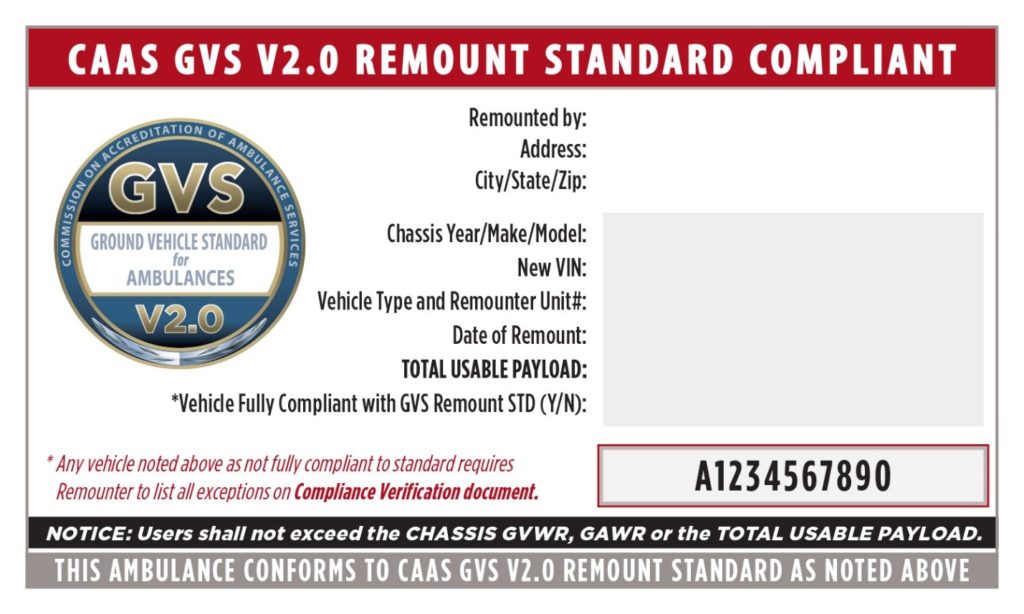
The CAAS GVS V2.0 serialized Remount Compliance Sticker provides verification by the REMOUNTER that they have successfully remounted your vehicle in compliance with the CAAS GVS V2.0 Remount Standard.
NOTE: CAAS GVS provides these stickers and associated document templates to Remounters who attest that they will comply with all verification and certification requirements for vehicles they produce. Buyers should perform their own due diligence to verify that the REMOUNTER is in compliance per Section F. CAAS GVS provides no recommendation or validation of any REMOUNTER, and cannot be held responsible for any discrepancy, misunderstanding or misrepresentation by a REMOUNTER.
The sticker provides vital information about your vehicle, including TOTAL USEABLE PAYLOAD, as well as a caution that the vehicle should never be used if the chassis Gross Vehicle Weight Rating (GVWR), Gross Axle Weight Ratings (GAWR) or the Total Useable Payload are exceeded. See section F for additional information.
Your vehicle may not be fully compliant if some exception/variance to a minimum requirement in the GVS Remount Standard has been mandated by you or the REMOUNTER. The REMOUNTER provided sticker states that the vehicle IS or IS NOT fully compliant to the GVS Remount Standard by displaying a “Y” or “N” in the last field of the window. If the vehicle is not fully compliant for any reason (an “N” has been entered in the field), the REMOUNTER must list all exceptions/variances to the standard on the Vehicle Compliance and Exception/Variance Verification document provided to you. Be aware that vehicles not fully compliant may not be eligible for licensure in your operating area based on local/state regulations and requirements. Contact your State EMS Office if you have any questions regarding compliance with State regulations.
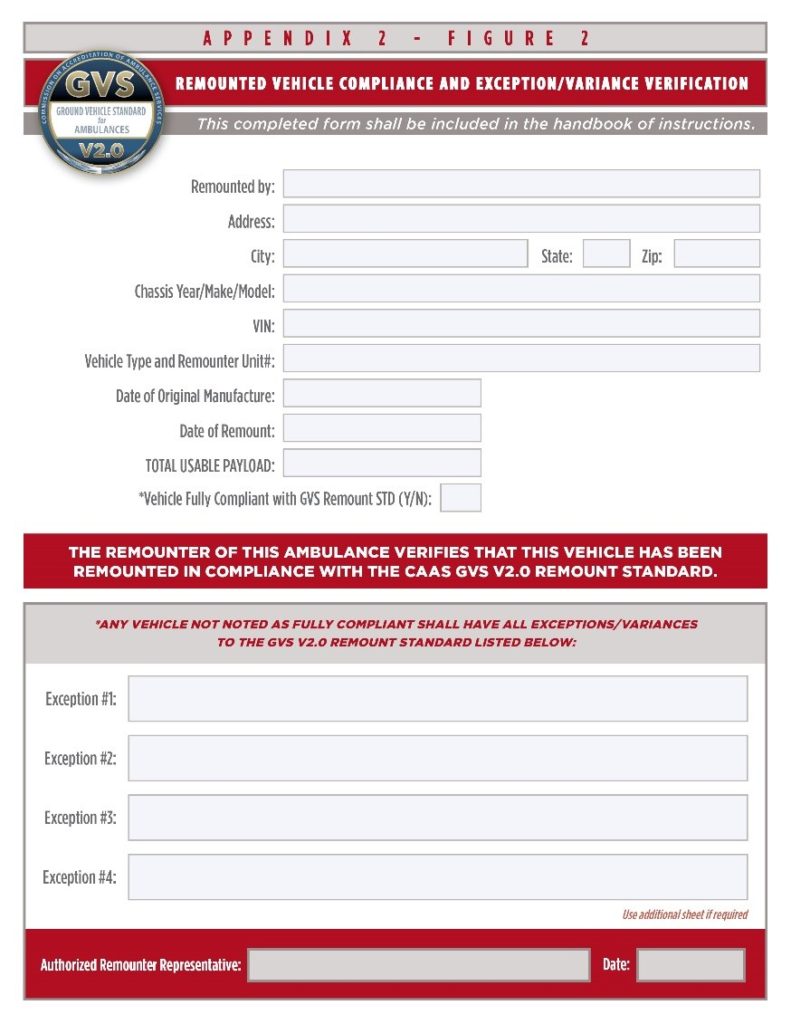
The Vehicle Compliance and Exception/Variance Verification document requires the REMOUNTER to provide further detail on any exceptions to compliance of your specific vehicle to the CAAS GVS Remount Standard. Like the Compliance Sticker referenced above, this document states that the vehicle IS or IS NOT fully certified to the GVS standard by displaying a “Y” or “N” in the last field of the upper window. If the vehicle is not fully certified for any reason (an “N” has been entered in the field), the REMOUNTER must list all exceptions/variances to the standard on the bottom half of the document.
The CAAS GVS registered Remounter, by providing the GVS Remount Standard Compliance label and accompanying documents as shown, verifies that the remount process has been completed in compliance with the CAAS GVS Remount Standard. This label does not provide or imply certification to either the CAAS GVS, KKK-A-1822 or NFPA 1917 new ambulance certification standards.
Be aware that vehicles not fully compliant certified may not be eligible for licensure in your operating area based on local/state regulations and requirements. Contact your State EMS Office if you have any questions about these criteria. The document shall be signed by an authorized employee of the REMOUNTER.
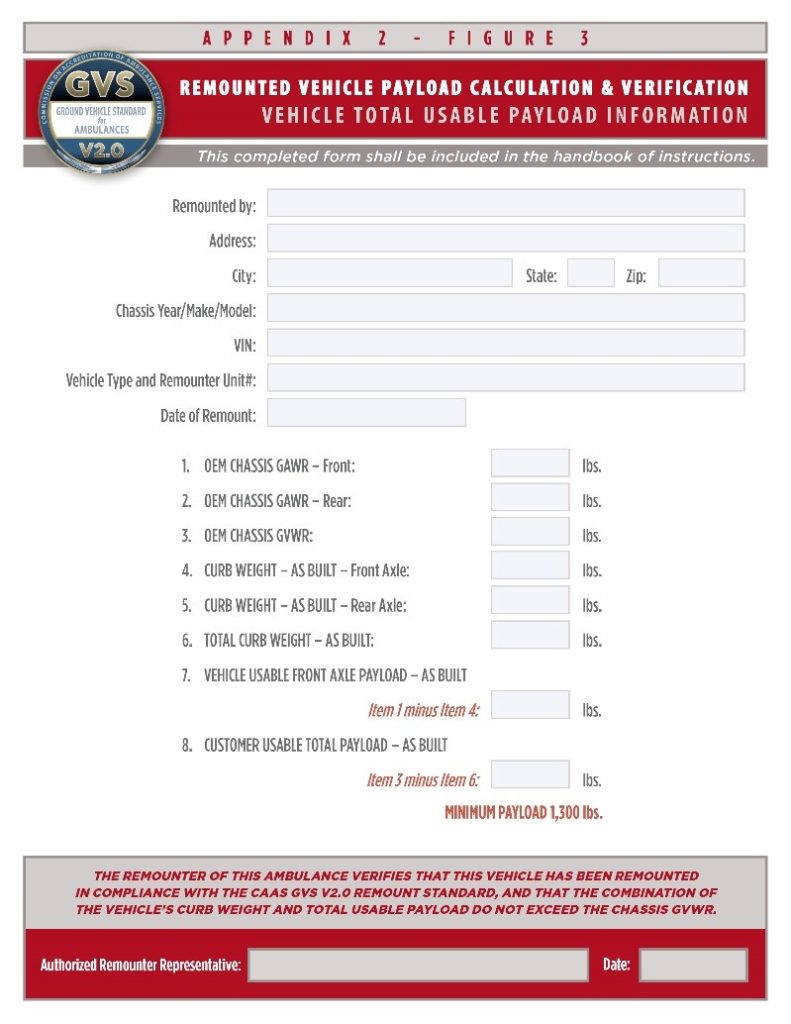
The Payload Calculation and Verification document requires the REMOUNTER to provide further detail on the weight and payload of your specific vehicle in accordance with the CAAS GVS standard. The document provides detailed information and payload calculations for your vehicle. Item 8 provides your TOTAL USEABLE PAYLOAD, which cannot be less than the 1300 pound minimum required by GVS F.6.5.
Users should also be aware of both the Vehicle Useable Front and Rear Axle Payloads when determining equipment and passenger requirements for the vehicle fully outfitted for service. Additional criteria for weight distribution and balance are outlined in GVS C.6 and must be followed.
NOTE: IT IS HIGHLY RECOMMENDED THAT THE USER WEIGH THE COMPLETED VEHICLE, INCLUDING A FULL COMPLIMENT OF EQUIPMENT, FUEL AND PASSENGERS AFTER THE UNIT IS FULLY OUTFITTED FOR SERVICE AND PRIOR TO OPERATION. The vehicle should never be used if the chassis Gross Vehicle Weight Rating (GVWR), Gross Axle Weight Ratings (GAWR) or the Total Useable Payload are exceeded. See section C.5 for additional information. The document shall be signed by an authorized employee of the REMOUNTER.
SPECIAL NOTES FOR GVS COMPLIANT REMOUNTED AMBULANCES:
NOTE 1: The CAAS GVS registered Remounter, by providing the GVS Remount Standard Compliance label, verifies that the remount process has been completed in compliance with the CAAS GVS Remount Standard. This label does not provide or imply certification to either the CAAS GVS, KKK-A-1822 or NFPA 1917 new ambulance certification standards. See GVS V2.0 F.6.7.
NOTE 2: THE US GENERAL SERVICES ADMINISTRATION STATES THAT “THE STAR OF LIFE” CERTIFICATION STICKER IS NOT TRANSFERABLE TO A REMOUNTED AMBULANCE. A VALID KKK CERTIFICATION STICKER MUST DISPLAY THE CORRECT VIN NUMBER OF THE CHASSIS CURRENTLY IN USE.
NOTE 3: It is the responsibility of the Purchaser to determine if their State and/or local EMS licensing authority will permit the specific remounted vehicle with GVS Remount Standard Compliance label for licensure and operation in the Purchaser’s service area.
FOR ADDITIONAL INFORMATION: info@groundvehiclestandard.org
